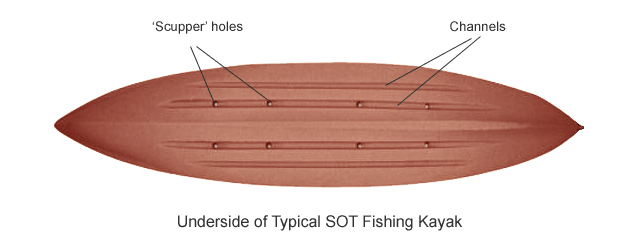Have you ever seen a picture of the underside of a sit-on-top (SOT) kayak? –
It’s unique, and the bottom of no other vessel looks like it.
Below is a figure showing what a typical SOT kayak looks like when it’s turned over:
Understanding the design of SOT kayaks’ underside
The ‘scupper’ holes
The most striking feature in a SOT kayak’s hull are the holes in it:
All SOT kayaks feature vertical holes connecting their deck to the water below. Kayak manufacturers call them ‘Scupper Holes’ and claim they were introduced into the SOT design as means to drain water from the kayak’s deck, similarly to what scuppers do in normal boats.
The truth is different –
To begin with, these vertical holes were introduced into the SOT kayak design not as means to drain their deck but for a totally different reason: They support the deck from crashing down as the user sits on top of it –
Kayaks’ hulls have thin plastic walls, and SOT kayaks’ hulls have a general form of an empty and flattish eggshell that’s not very strong, which is why its top side (let’s call it the ‘roof’) requires reinforcement.
The way to support the roof of a large structure is by means of vertical columns, and that’s essentially what scupper holes are: vertical, molded-in plastic tubes that act as supporting columns for the kayak’s deck.
This explains why scupper holes are rather dysfunctional as drainage holes – They were not designed as such in the first place.
So next time you paddle a SOT kayak and you notice water splashing through the scupper holes onto the deck as a result of the kayak moving in the water (that’s what kayaks are supposed to do), you’ll know why the manufacturer just had to put these holes there, and why the sensible solution of letting water drain from the kayak’s deck to its sides didn’t get adopted…
The faulty hydrodynamics of scupper holes
Any detail in a vessel’s hull that can generate a noticeable change in the regular flow of the water is unwanted since it increases drag (resistance) and makes it harder to move the vessel. In other words, it slows the vessel down.
Therefore, a hull that features multiple drag generating elements such as scupper holes is very slow, and in kayaking terms it’s hard to paddle or pedal it forward at an acceptable speed without the kayaker making an unusual effort.
Call it a barge and you’d be spot on.
Channels and Tunnels
The second striking element that SOT kayak feature on their underside are channels sometime called tunnels. These are the long and narrow grooves stretching along the hull’s middle section.
Why are they there? –
Water cannot be compressed, and it doesn’t like to be forced into narrow and long structures such as these. When it does, it generates friction (Frictional Resistance – FR) and turbulence, and thereby even more drag making the kayak even harder to move, I.E. much slower.
Kayak designers know these facts, or at least they’re supposed to be aware of them, so why do they add such channels to their kayaks’ underside? –
The typical answer you’d hear at a kayak dealership is that channels add to the kayak’s tracking capability. This should be a good thing because SOT kayaks or at least those designed to serve anglers track exceptionally poorly, which is why nearly all of them come equipped with a rudder (yet another undesirable element). But if a kayak features a rudder, it doesn’t need such channels molded into its underside…
So this common explanation is false, and it masks reality –
If indeed channels are there to improve tracking, why does only the middle section of SOT (and ‘hybrid’) kayaks feature them? It would make sense to make such channels longer, so they produce a more noticeable tracking effect, wouldn’t it?
Well, the reality is that such channels are essentially yet another means to reinforce the SOT kayak’s hull, which is why they coincide with scupper holes –
Knowing that the lower end of scupper tube generates considerable drag as it comes in contact with water, the kayak designer may attempt to position it higher, that is at the top side of a narrow tunnel, such as can be observed in the above image.
It doesn’t really work, simply because the kayak sinks lower in the water as soon as it is loaded with a passenger, and if that passenger happens to be an angler, the load is heavier since it includes fishing gear as well.
Other SOT kayak underside elements that slows it down
If you thought that kayak designers and manufacturers would stop at scuppers and channels, you were wrong. In fact, in the race between kayak manufacturers to overdo each other by introducing details and accessories in increasing numbers, many SOT kayaks today feature additional elements that generate extra drag, and further slow you down –
Those include fins, keels and skegs, and pedal driven kayaks feature flapping fins or propellers.
The additional effort required to propel SOT or hybrid kayaks that feature such elements is significantly greater than the effort required to propel simple sit-in kayaks of similar proportions, and it’s much greater than the effort required to propel a W kayak.
Clearly, as SOT kayaks become bigger, wider, heavier, over accessorized and dysfunctional through clutter, we are witnessing the end of a design cycle that began sometime in the end of the 1960s, when people started outfitting paddle boards with seats and footrests and called them sit-on-top kayaks…
Do you have any questions for us?


